Fabrication, Microstructure, and Properties of In Situ V2C-Reinforced Copper Composites
Abstract
:1. Introduction
2. Experimental Procedure
3. Results and Discussion
3.1. Phase Composition and Microstructure
3.2. Physical Properties
3.3. Mechanical Properties
4. Conclusions
- i.
- V2SnC completely decomposed into V2C and Sn because the Sn-based MAX phase easily precipitated Sn atoms under high temperatures and pressures. Sn entered the crystal structure of copper to form a solid solution. As a result of increasing V2SnC content, the lattice constant of copper increased from 3.6001 Å to 3.7192 Å. Due to the decomposition of V2SnC, phase compositions of the composite consisted of V2C and copper.
- ii.
- With increasing V2C content, the scattering of electrons was improved. Consequently, the electrical and thermal conductivities of the composites decreased from 0.589 × 108 S·m−1 to 0.034 × 108 S·m−1 and from 384.36 W·m−1⋅K−1 to 24.65 W·m−1·K−1, respectively.
- iii.
- The introduction of V2C resulted in reinforcement of the Cu matrix by dispersion strengthening, grain refinement, and solid-solution strengthening. As a result, the hardness and strength of composite were improved. The Vickers hardness of composites increased from 52.6 HV to 334 HV with increasing V2C content. The Cu composite with 20 vol.% V2C had the highest tensile strength of 440 MPa, which was nearly three times that of pure Cu (160 MPa). When the content of V2C exceeded 30 vol.%, the tensile strength decreased due to embrittlement.
Author Contributions
Funding
Institutional Review Board Statement
Informed Consent Statement
Data Availability Statement
Conflicts of Interest
References
- Huang, X.; Feng, Y.; Qian, G.; Zhao, H.; Zhang, J.; Zhang, X. Physical, mechanical, and ablation properties of Cu–Ti3AlC2 composites with various Ti3AlC2 contents. Mater. Sci. Technol. 2018, 34, 757–762. [Google Scholar] [CrossRef]
- Zeng, L.; You, C.; Zhang, X.; Liang, T.; Miao, S.; Liu, B. Preparation of bulk Cu-W interpenetrating-phase composites by liquid metal dealloying. Int. J. Refract. Met. Hard Mater. 2021, 97, 105503. [Google Scholar] [CrossRef]
- Wang, B.A.; Wang, N.; Yang, Y.J.; Zhong, H.; Ma, M.Z.; Zhang, X.Y.; Liu, R.P. Microstructure and mechanical properties of ZrO2 particle dispersion strengthened 16MnV steel. Mater. Sci. Eng. A 2017, 692, 168–173. [Google Scholar] [CrossRef]
- Dalvand, A.; Ahmadi, M. Impact failure mechanism and mechanical characteristics of steel fiber reinforced self-compacting cementitious composites containing silica fume. Eng. Sci. Technol. Int. J. 2021, 24, 736–748. [Google Scholar] [CrossRef]
- Xue, R.; Liu, P.; Zhang, Z.; Zhang, N.; Zhang, Y.; Wang, J. Improvement of toughness of reaction bonded silicon carbide composites reinforced by surface-modified SiC whiskers. Ceram. Int. 2021, 47, 18150–18156. [Google Scholar] [CrossRef]
- Luo, G.; Chen, J.; Qin, J.; Sun, Y.; Zhang, J.; Li, Y.; Shen, Q. Microstructure and strengthening mechanism of boride in-situ reinforced titanium matrix composites prepared by plasma activated sintering. Ceram. Int. 2021, 47, 15910–15922. [Google Scholar] [CrossRef]
- Wątroba, M.; Bednarczyk, W.; Kawałko, J.; Bała, P. Fine-tuning of mechanical properties in a Zn–Ag–Mg alloy via cold plastic deformation process and post-deformation annealing. Bioact. Mater. 2021, 6, 3424–3436. [Google Scholar] [CrossRef]
- Palma, R.H.; Sepúlveda, A.O.; Espinoza, R.G.; Zúñiga, A.P.; Diánez, M.J.; Criado, J.M.; Sayagués, M.J. High-temperature mechanical behaviour of Cu-Ti-C, Cu-Al and Cu-Ti-Al-C alloys obtained by reaction milling. Mater. Sci. Eng. A 2004, 384, 262–269. [Google Scholar] [CrossRef]
- Bagheri, G.A. The effect of reinforcement percentages on properties of copper matrix composites reinforced with TiC particles. J. Alloy. Compd. 2016, 676, 120–126. [Google Scholar] [CrossRef]
- Akbarpour, M.R.; Mousa Mirabad, H.; Alipour, S. Microstructural and mechanical characteristics of hybrid SiC/Cu composites with nano- and micro-sized SiC particles. Ceram. Int. 2019, 45, 3276–3283. [Google Scholar] [CrossRef]
- Chrysanthou, A.; Erbaccio, G. Production of copper-matrix composites by in situ processing. J. Mater. Sci. 1995, 30, 6339–6344. [Google Scholar] [CrossRef]
- Feng, T.; Zheng, W.; Chen, W.; Shi, Y.; Fu, Y.Q. Enhanced interfacial wettability and mechanical properties of Ni@Al2O3/Cu ceramic matrix composites using spark plasma sintering of Ni coated Al2O3 powders. Vacuum 2021, 184, 109938. [Google Scholar] [CrossRef]
- Oanh, N.T.H.; Viet, N.H.; Kim, J.S.; Dudina, D.V. Structural investigations of TiC–Cu nanocomposites prepared by ball milling and spark plasma sintering. Metals 2017, 7, 123. [Google Scholar]
- Oanh, N.T.H.; Viet, N.H.; Kim, J.S.; Moreira Jorge Junior, A. Characterization of In-Situ Cu-TiH2-C and Cu-Ti-C nanocomposites produced by mechanical milling and spark plasma sintering. Metals 2017, 7, 117. [Google Scholar] [CrossRef] [Green Version]
- Fu, S.; Liu, Y.; Zhang, H.; Grasso, S.; Hu, C. Synthesis and characterization of high purity Mo2Ti2AlC3 ceramic. J. Alloy. Compd. 2020, 815, 152485. [Google Scholar] [CrossRef]
- Niu, Y.; Fu, S.; Zhang, K.; Dai, B.; Zhang, H.; Grasso, S.; Hu, C. Synthesis, microstructure, and properties of high purity Mo2TiAlC2 ceramics fabricated by spark plasma sintering. J. Adv. Ceram. 2020, 9, 759–768. [Google Scholar] [CrossRef]
- Zhang, Z.; Duan, X.; Qiu, B.; Yang, Z.; Cai, D.; He, P.; Jia, D.; Zhou, Y. Preparation and anisotropic properties of textured structural ceramics: A review. J. Adv. Ceram. 2019, 8, 289–332. [Google Scholar] [CrossRef] [Green Version]
- Tabares, E.; Jiménez-Morales, A.; Tsipas, S.A. Study of the synthesis of MAX phase Ti3SiC2 powders by pressureless sintering. Bol. Soc. Esp. Ceram. Vidr. 2021, 60, 41–52. [Google Scholar] [CrossRef]
- Zhao, Y.; Deng, S.; Liu, H.; Zhang, J.; Guo, Z.; Hou, H. First-principle investigation of pressure and temperature influence on structural, mechanical and thermodynamic properties of Ti3AC2 (A = Al and Si). Comput. Mater. Sci. 2018, 154, 365–370. [Google Scholar] [CrossRef]
- Chen, L.; Duan, G.; Gao, X.F.; Wang, C.L. Property of mono-vacancy in MAX phase M3AC2 (M = Ti, A = Al, Si, or Ge): First-principles calculations. Mod. Phys. Lett. B 2018, 32, 1–7. [Google Scholar] [CrossRef]
- Akhlaghi, M.; Tayebifard, S.A.; Salahi, E.; Shahedi Asl, M.; Schmidt, G. Self-propagating high-temperature synthesis of Ti3AlC2 MAX phase from mechanically-activated Ti/Al/graphite powder mixture. Ceram. Int. 2018, 44, 9671–9678. [Google Scholar] [CrossRef]
- Abbas, N.; Qin, X.; Ali, S.; Zhu, G.; Lu, J.; Alam, F.E.; Wattoo, A.G.; Zeng, X.; Gu, K.; Tang, J. Direct deposition of extremely low interface-contact-resistant Ti2AlC MAX-phase coating on stainless-steel by mid-frequency magnetron sputtering method. J. Eur. Ceram. Soc. 2020, 40, 3338–3342. [Google Scholar] [CrossRef]
- Li, M.; Zhai, H.; Huang, Z.; Liu, X.; Zhou, Y.; Li, S.; Li, C. Microstructure and mechanical properties of TiC0.5 reinforced copper matrix composites. Mater. Sci. Eng. A 2013, 588, 335–339. [Google Scholar] [CrossRef]
- Howe, J.M. Bonding, structure, and properties of metal/ceramic interfaces: Part 1 chemical bonding, chemical reaction, and interfacial structure. Int. Mater. Rev. 1993, 38, 233–256. [Google Scholar] [CrossRef]
- Xiao, P.; Derby, B. Wetting of titanium nitride and titanium carbide by liquid metals. Acta Mater. 1996, 44, 307–314. [Google Scholar] [CrossRef]
- Zhang, J.; Zhou, Y.C. Microstructure, mechanical, and electrical properties of Cu-Ti3AlC2 and in situ Cu-TiCx composites. J. Mater. Res. 2008, 23, 924–932. [Google Scholar] [CrossRef]
- Dudina, D.V.; Mali, V.I.; Anisimov, A.G.; Bulina, N.V.; Korchagin, M.A.; Lomovsky, O.I.; Bataev, I.A.; Bataev, V.A. Ti3SiC2-Cu composites by mechanical milling and spark plasma sintering: Possible microstructure formation scenarios. Met. Mater. Int. 2013, 19, 1235–1241. [Google Scholar] [CrossRef]
- Wu, J.; Zhou, Y.; Yan, C. Mechanical and electrical properties of Ti2SnC dispersion-strengthened copper. Z. Metallkd. 2005, 96, 847–852. [Google Scholar] [CrossRef]
- Xu, Q.; Zhou, Y.; Zhang, H.; Jiang, A.; Tao, Q.; Lu, J.; Rosén, J.; Niu, Y.; Grasso, S.; Hu, C. Theoretical prediction, synthesis, and crystal structure determination of new MAX phase compound V2SnC. J. Adv. Ceram. 2020, 9, 481–492. [Google Scholar] [CrossRef]
- Zhang, J.; Liu, B.; Wang, J.Y.; Zhou, Y.C. Low-temperature instability of Ti2SnC: A combined transmission electron microscopy, differential scanning calorimetry, and X-ray diffraction investigations. J. Mater. Res. 2009, 24, 39–49. [Google Scholar] [CrossRef]
- Barsoum, M.W.; Yaroschuk, G.; Tyagi, S. Fabrication and characterization of M2SnC (M = Ti, Zr, Hf and Nb). Scr. Mater. 1997, 37, 1583–1591. [Google Scholar] [CrossRef]
- Wu, J.; Zhou, Y.; Wang, J.; Wang, W.; Yan, C. Interfacial reaction between Cu and Ti2SnC during processing of Cu-Ti2SnC composite. Z. Fuer Met. Res. Adv. Tech. 2005, 96, 1314–1320. [Google Scholar] [CrossRef]
- Jin, S.; Su, T.; Hu, Q.; Zhou, A. Thermal conductivity and electrical transport properties of double-A-layer MAX phase Mo2Ga2C. Mater. Res. Lett. 2020, 8, 158–164. [Google Scholar] [CrossRef] [Green Version]
- Chen, Y.; Liang, H.; Xia, X.; Tao, P.; Shen, R.; Liu, Y.; Feng, Y.; Zheng, Y.; Li, X.; Du, G. The lattice distortion of β-Ga2O3 film grown on c-plane sapphire. J. Mater. Sci. Mater. Electron. 2015, 26, 3231–3235. [Google Scholar] [CrossRef]
- Zhang, P.G.; Ding, J.X.; Liu, Y.S.; Yang, L.; Tian, W.B.; Ouyang, J.; Zhang, Y.M.; Sun, Z.M. Mechanism and mitigation of spontaneous Ga whisker growth on Cr2GaC. Sci. China Technol. Sci. 2020, 63, 440–445. [Google Scholar] [CrossRef]
- Huang, B.S.; Fu, S.; Zhang, S.S.; Ju, C.Y.; Wu, S.S.; Peng, H. Preparation and property test of porous Cu-Sn alloy by powder filling and sintering method. Mater. Res. Express 2019, 6, 1–10. [Google Scholar] [CrossRef]
- Liang, B.; Han, D.; Zhang, W. Fabrication and Wear Performance of (Cu–Sn) Solution/TiCx Bonded Diamond Composites. J. Superhard Mater. 2018, 40, 179–183. [Google Scholar] [CrossRef]
- Zhang, Q.G.; Cao, B.Y.; Zhang, X.; Fujii, M.; Takahashi, K. Influence of grain boundary scattering on the electrical and thermal conductivities of polycrystalline gold nanofilms. Phys. Rev. B–Condens. Matter Mater. Phys. 2006, 74, 1–5. [Google Scholar] [CrossRef]
- Ma, A.; Wang, X.; Chen, Y.; Yu, J.; Zheng, W.; Zhao, Y. Largely enhanced thermal conductivity of ethylene-propylene-diene monomer composites by addition of graphene ball. Compos. Commun. 2019, 13, 119–124. [Google Scholar] [CrossRef]
- Wei, J.; Liao, M.; Ma, A.; Chen, Y.; Duan, Z.; Hou, X.; Li, M.; Jiang, N.; Yu, J. Enhanced thermal conductivity of polydimethylsiloxane composites with carbon fiber. Compos. Commun. 2020, 17, 141–146. [Google Scholar] [CrossRef]
- Wang, T.; Yu, J.; Wang, M.; Cao, Y.; Dai, W.; Shen, D.; Guo, L.; Wu, Y.; Bai, H.; Dai, D.; et al. Effect of different sizes of graphene on thermal transport performance of graphene paper. Compos. Commun. 2017, 5, 46–53. [Google Scholar] [CrossRef]
- Zhang, M.; Liu, L.; Liang, S.; Li, J. Evolution in microstructures and mechanical properties of pure copper subjected to severe plastic deformation. Met. Mater. Int. 2020, 26, 1585–1595. [Google Scholar] [CrossRef]
- Ma, R.; Guo, X. Effects of Mo and Zr composite additions on the microstructure, mechanical properties and oxidation resistance of multi-elemental Nb-Si based ultrahigh temperature alloys. J. Alloy. Compd. 2021, 870, 159437. [Google Scholar] [CrossRef]
- Kwon, H.; Suh, C.Y. Hardening of Ti(CN)–Fe composites by microstructural refinement and solid solution strengthening of metallic phase. Ceram. Int. 2021, 47, 13927–13933. [Google Scholar] [CrossRef]

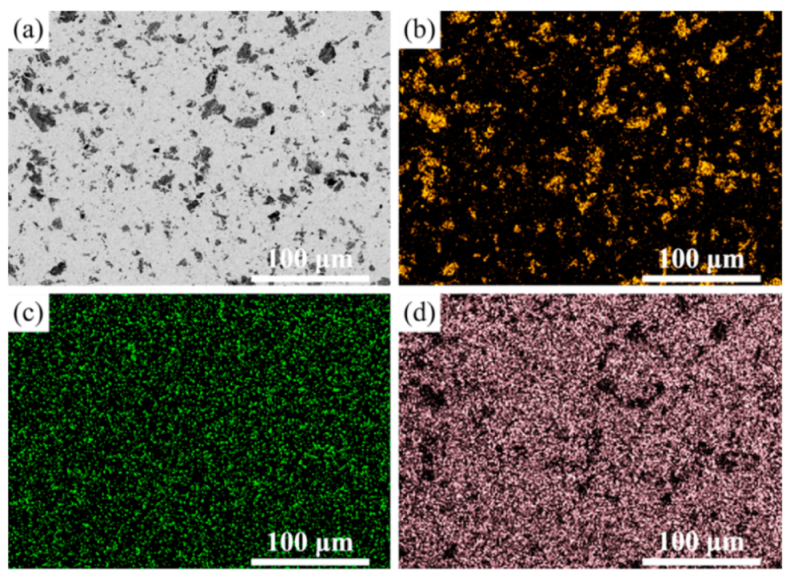


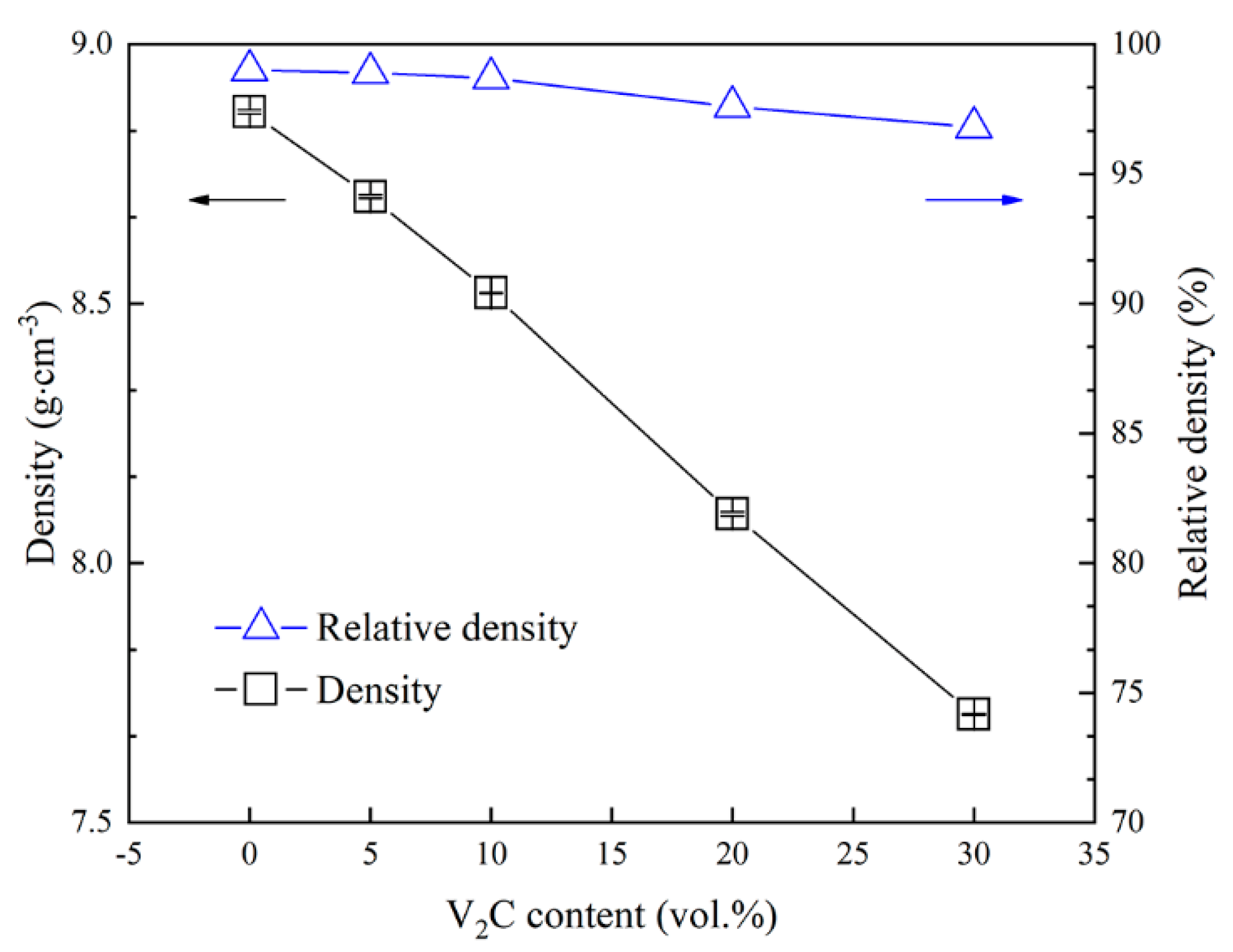
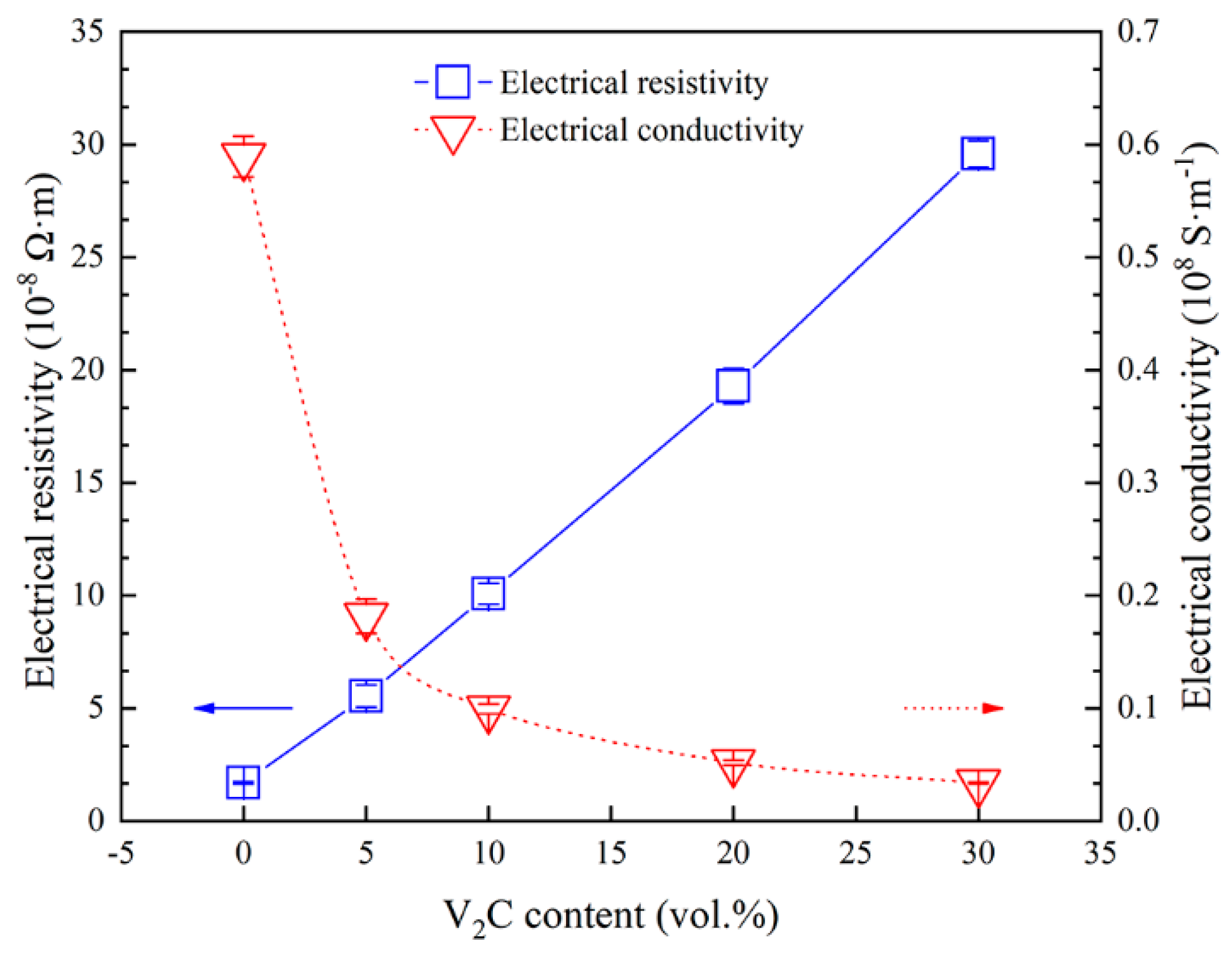
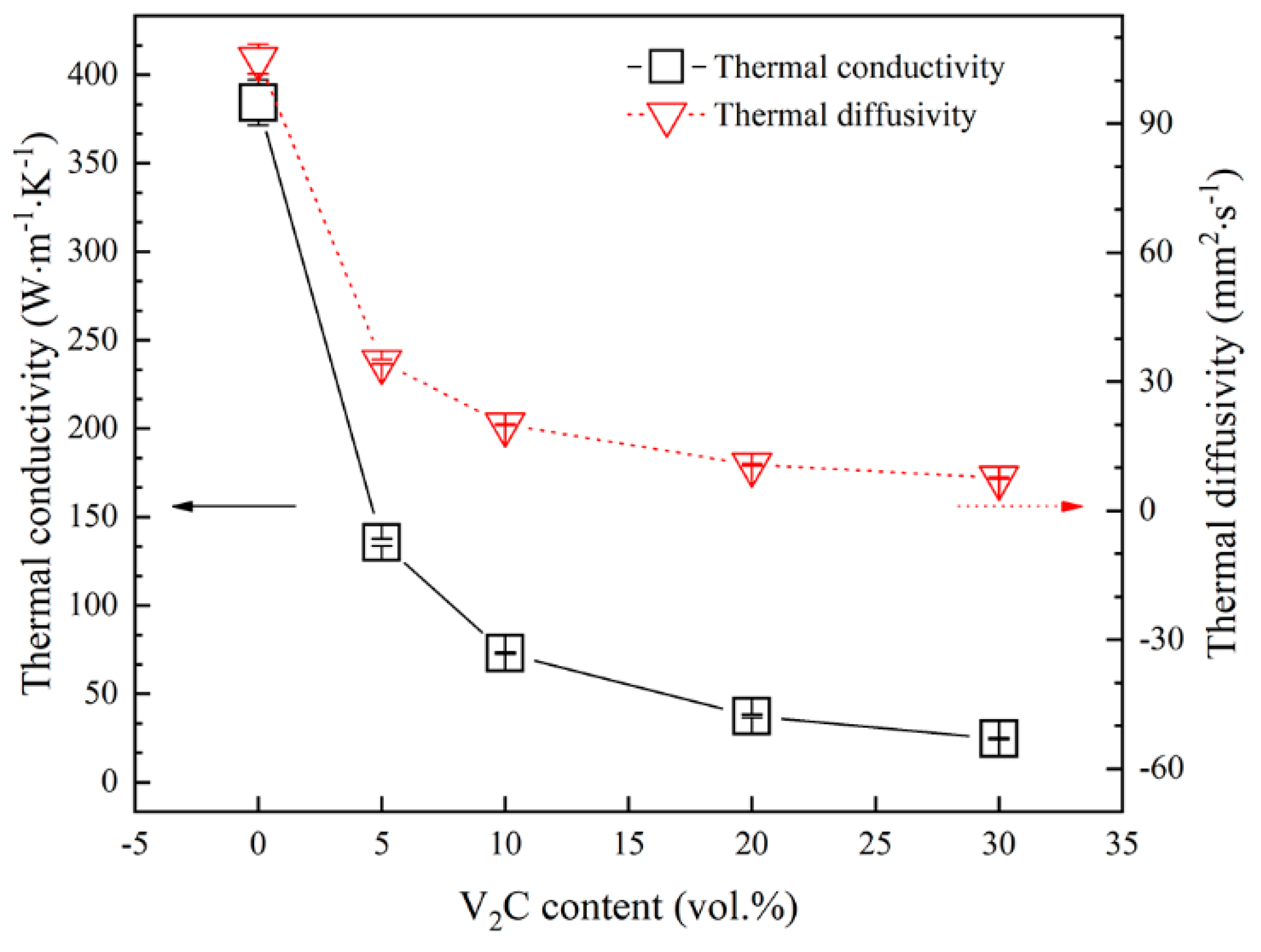
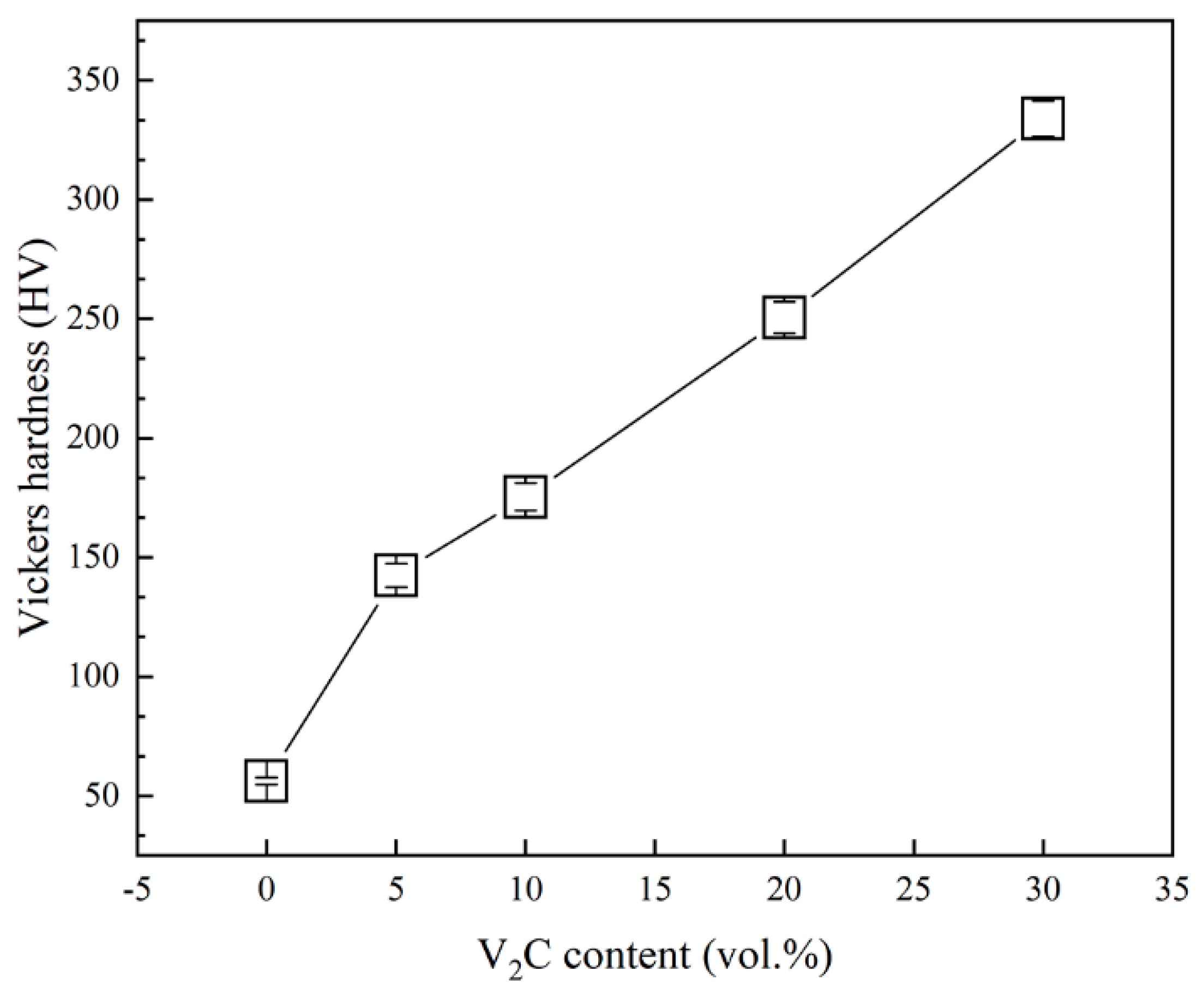

| Composites | Pure Cu | S1 | S2 | S3 | S4 |
|---|---|---|---|---|---|
| Lattice constant (Å) (a = b = c) | 3.6001 | 3.6181 | 3.6553 | 3.6806 | 3.7192 |
| Composites | Tensile Strength (MPa) | Electrical Conductivity (%IACS) | Preparing Method | Reference |
|---|---|---|---|---|
| Pure Cu | 160 | 98 | Hot pressing | This work |
| V2C (5 vol.%)-Cu | 332 | 31.4 | ||
| V2C (10 vol.%)-Cu | 362 | 17 | ||
| V2C (20 vol.%)-Cu | 440 | 9 | ||
| V2C (30 vol.%)-Cu | 349 | 5.8 | ||
| Pure Cu | 130 | 84.7 | Hot pressing | Ref. [25] |
| TiCx (5 vol.%)-Cu | 315 | 30 | ||
| TiCx (10 vol.%)-Cu | 356 | 16 | ||
| TiCx (20 vol.%)-Cu | 392 | 9 | ||
| TiCx (30 vol.%)-Cu | 299 | 6 |
Publisher’s Note: MDPI stays neutral with regard to jurisdictional claims in published maps and institutional affiliations. |
© 2021 by the authors. Licensee MDPI, Basel, Switzerland. This article is an open access article distributed under the terms and conditions of the Creative Commons Attribution (CC BY) license (https://creativecommons.org/licenses/by/4.0/).
Share and Cite
Quan, Y.; Hu, B.; Fu, S.; Wan, D.; Bao, Y.; Feng, Q.; Grasso, S.; Hu, C. Fabrication, Microstructure, and Properties of In Situ V2C-Reinforced Copper Composites. Metals 2021, 11, 1829. https://doi.org/10.3390/met11111829
Quan Y, Hu B, Fu S, Wan D, Bao Y, Feng Q, Grasso S, Hu C. Fabrication, Microstructure, and Properties of In Situ V2C-Reinforced Copper Composites. Metals. 2021; 11(11):1829. https://doi.org/10.3390/met11111829
Chicago/Turabian StyleQuan, Yu, Baotong Hu, Shuai Fu, Detian Wan, Yiwang Bao, Qingguo Feng, Salvatore Grasso, and Chunfeng Hu. 2021. "Fabrication, Microstructure, and Properties of In Situ V2C-Reinforced Copper Composites" Metals 11, no. 11: 1829. https://doi.org/10.3390/met11111829
APA StyleQuan, Y., Hu, B., Fu, S., Wan, D., Bao, Y., Feng, Q., Grasso, S., & Hu, C. (2021). Fabrication, Microstructure, and Properties of In Situ V2C-Reinforced Copper Composites. Metals, 11(11), 1829. https://doi.org/10.3390/met11111829








